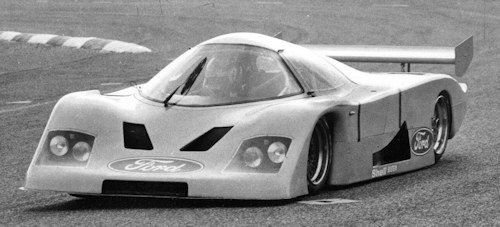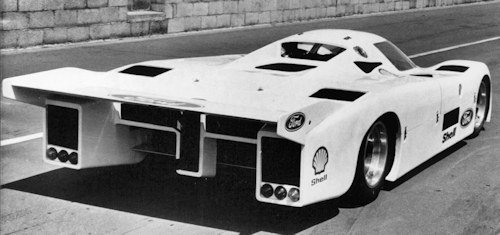Ford C 100 race car
 |
|
|
Production period: |
1981 to 1982 |
|
Class : |
race car |
|
Body versions : |
Coupe |
|
Engines: |
Gasoline : 1.8-3.9 liters(405-441 kW) |
|
Transmission: |
Five-speed manual gearbox |
|
Suspension: |
independent; wishbones and coil springs, front and rear. |
|
Width: |
1710 mm |
|
wheelbase : |
95 in (240 cm) |
|
Curb weight : |
880 kg |
|
Max speed: |
200 mph/320 kmh. |
The Ford C 100 is a sports prototype of the car manufacturer Ford , which was developed and built according to the rules of the valid in 1982 Group C in Cologne .
History
The name is reminiscent of the successful 1960s Ford GT40 , and includes the class designation (GT and size C) and mandatory roof height (40 inches and 100 centimeters, respectively).Gasoline consumption was limited in Group C, but the engine design and displacement were almost arbitrary. This is similar to the situation at Le Mans in 1975 , when similar rules applied after the oil crisis.

The victorious in Formula 1 since 1967 Ford Cosworth DFV V8 engine, which had previously been problematic on long hauls by vibration, was the engine in the top three cars. Also in 1980 won a sports car with Cosworth engine against a disguised Porsche 936 with turbo engine.Thus, Ford gave with justified optimism green light for the development of the sports prototype C 100.The first chassis was a straight forward aluminium
monocoque built by Hesketh, with a mid-mounted Ford DFL engine and Hewland gearbox. The Cosworth engine, which was also inferior in Formula 1 as a short-stroke DFY three-liter with about 386 kW (525 hp) against the turbo engines , was enlarged as DFL to 3.9 liters capacity. Thus, he should be able to deliver more power and torque, especially since the competitors of Porsche and Lancia had turbo engines with about 441 kW (600 hp). Among them suffered the reliability of the DFL, the Le Mans in 1982 and 1983 disappointed in both the C 100 and in other vehicles. The cars lacked speed as well as reliability . The DFL variant of the Cosworth engine was reduced to 3.3 liters. The Ford factory project was set in late 1982 after just a full season, similar to the already equipped with the Cosworth V8 prototype Ford P68 from 1968 and 1969.
Zakspeed also used modified C 100 in 1983. These were called C1 / 8 when the eight-cylinder was on board, and C1 / 4 with the proven 1.8-liter 4-cylinder turbo engine from the Group 5 Capri, which made 412 kW (560 hp). With the V8 Klaus Niedzwiedz managed a victory at Hockenheim, Ludwig reached with the C1 / 4 the fastest lap. Then Zakspeed moved into Formula 1.

